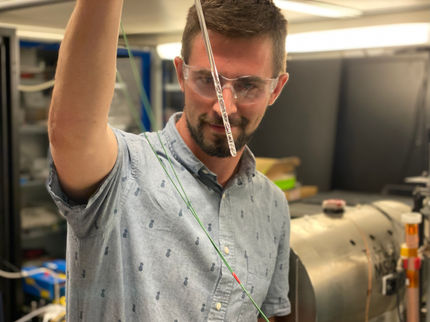A natural boost for MRI scans
magnetic resonance imaging (MRI) is a technique widely used in medicine to create images of internal organs such as the heart, the lungs, the liver and even the brain. Since its invention in 1977, MRI has become a staple of clinical radiology, used across the world to identify health problems in millions of patients worldwide. But despite its prominence, MRI suffers from low sensitivity, which can be improved by injecting patients with potentially toxic agents. Publishing in PNAS, researchers from EPFL have found a way to achieve high spatial and temporal resolution MRI using a safe compound that is naturally produced in the body.
MRI works by manipulating the alignment of the body's hydrogen atoms, which are susceptible to magnetic fields. Normally, our body's atoms spin around randomly, without any observable direction. During an MRI scan, a powerful magnet is used to generate a magnetic field that can be up to 40,000 times stronger than the Earth's. This causes approximately half the atoms to align towards the patient's head and the other half towards the feet.
The opposing alignment of the body's atoms cancels out much of the background 'noise', since for every atom lined up one way there is one lined up the opposite way. However, a few atoms per million (still a huge amount in total) line up in either direction without a cancelling counterpart. By reading out the energy levels of these atoms, the MRI computer can generate detailed images of the body, which can be central in diagnosing disease.
A well-known weakness of MRI is low sensitivity. This can be addressed with the use of hyperpolarization techniques, which involve injecting patients with substrates that contain a stable carbon isotope that is almost perfectly aligned with the machine's magnetic field. However, the preparation of these contrast agents requires the use of highly reactive chemicals called persistent radicals, which can be potentially toxic. Consequently, they have to also be filtered out prior to injecting the substrates and require additional pharmacological tests, all of which considerably reduce the MRI contrast, while posing a risk to the patient.
Researchers replace toxic chemicals with a natural substance
A research team led by Arnaud Comment developed a breakthrough solution to this problem. They found that high resolution in contrast-enhanced MRI can still be achieved with pyruvic acid, an organic chemical that occurs naturally in the body as a result of glucose breakdown, without the need of persistent radicals.
The scientists exposed frozen, pure pyruvic acid to ultraviolet light for an hour, which resulted in the generation of non-persistent radicals at a high concentration. The radicals automatically recombine to produce a solution only containing compounds that are naturally present in the body but in much lower concentrations. It was used to perform high-resolution MRI on a mouse brain. The resulting images showed detailed spatial and temporal resolution to the point of tracking the metabolism of pyruvic acid in the animal's brain.
The new hyperpolarization method opens a way to perform MRI with compounds that are not toxic, thus reducing or altogether eliminating associated health risks. In addition, because it does not require filtering or additional tests, the method will cut down on the time and cost of contrast-enhanced MRI protocols, thus improving the quality of the scans and diagnosis. The authors believe that the technique will be rapidly incorporated into the clinical setting and call it "a substantial step forward toward clinical radiology free of side effects".
Most read news
Other news from the department science

Get the life science industry in your inbox
By submitting this form you agree that LUMITOS AG will send you the newsletter(s) selected above by email. Your data will not be passed on to third parties. Your data will be stored and processed in accordance with our data protection regulations. LUMITOS may contact you by email for the purpose of advertising or market and opinion surveys. You can revoke your consent at any time without giving reasons to LUMITOS AG, Ernst-Augustin-Str. 2, 12489 Berlin, Germany or by e-mail at revoke@lumitos.com with effect for the future. In addition, each email contains a link to unsubscribe from the corresponding newsletter.
More news from our other portals
Last viewed contents

Obesity risk quantification: a jump towards the future through the lens of artificial intelligence applied to lipid science - Scientists and biotech start-up Lipotype teamed up
New marine compound derived from the sea slug against lung cancer and melanoma - PharmaMar initiates phase II trials in lung cancer and melanoma

Start-up Raises 16.3 million Euros to Prepare Market Launch of its SARS-CoV-2 Rapid Testing System - “Mini-laboratory” provides test results in 30 to 40 minutes
Pivotal study confirms potential of Novartis candidate vaccine Bexsero to help protect infants against meningococcal serogroup B disease
Evotec and Celgene expand iPSC collaboration to include additional cell lines
Bridging that Gap Between Research and Market - Europe is well positioned to spearhead the development of a bio-based economy but must invest in demonstration activities to gain a competitive edge, says new study























































